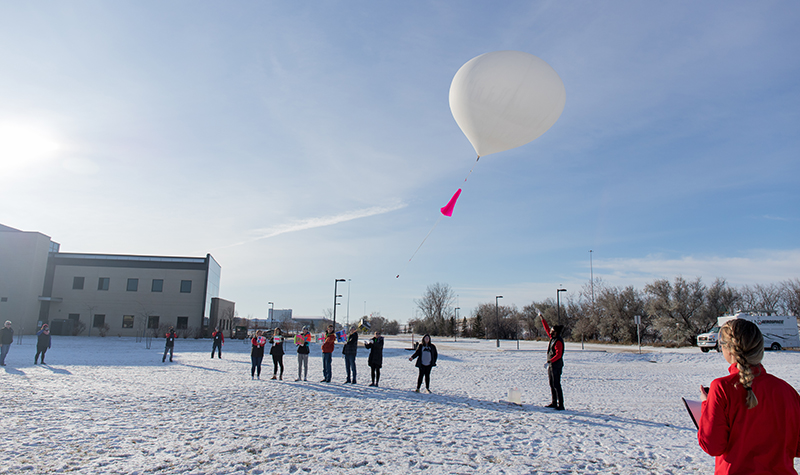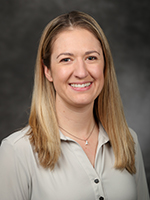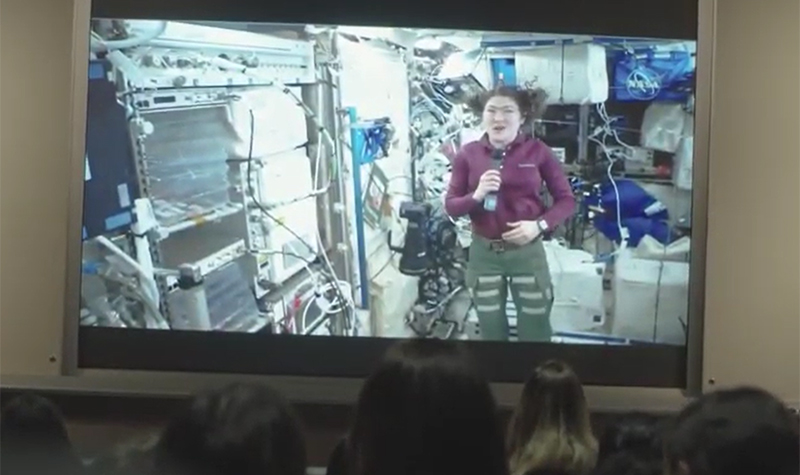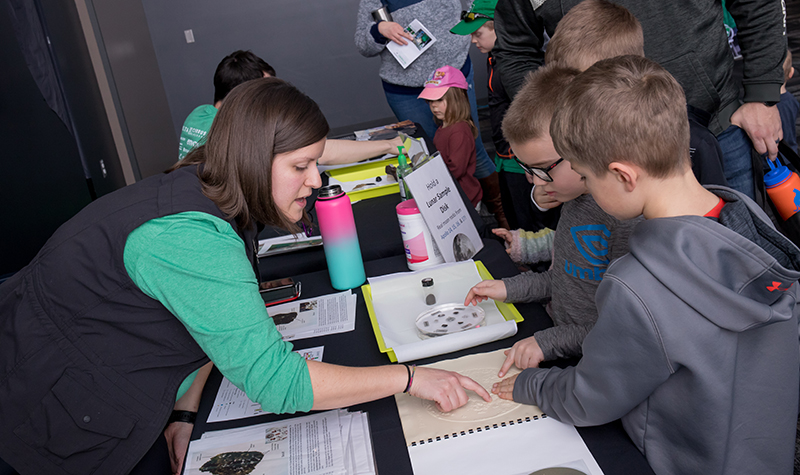North Dakota Space Grant Consortium turns 30
Decades of support, collaboration and outreach have paid off for Space Grant and its host institution, UND

Within the past two years, the University of North Dakota has received some high-profile attention from the nation’s space leaders.
Visits from people such as then-NASA Administrator Jim Bridenstine and Gen. John Raymond, Commander of the U.S. Space Force, have led UND’s own leaders to propose advancing the University’s space research and development capabilities.
Such proposals are already making their way through the North Dakota Legislature.
“There’s a promising frontier right in front of us,” said UND President Andy Armacost in October. “Let’s use the creative and scholarly talent of our faculty, students, and staff to make some magic happen.”
But it is not just the presence of such individuals that puts UND on the tips of tongues or heads of lists for space-research ventures. It’s a reputation – one that has developed over decades through the University’s own successes in not only aeronautics, but also space research.
One of the biggest examples of that space-related work is celebrating its 30th anniversary this month. For the past 30 years, as of Feb. 6, the North Dakota Space Grant Consortium has been carrying out its role as NASA’s premier presence in the state.
First established in 1989, the National Space Grant College and Fellowship Project is a national network of colleges and universities working to expand opportunities for Americans to understand and participate in NASA’s projects through education, research and public engagement. The network includes more than 850 affiliate organizations that belong to one of 52 consortia in all 50 states, the District of Columbia and Puerto Rico.
Supporting projects and activities aligned with NASA’s own objectives of research and exploration, NDSGC has reached thousands of students and educators across all levels of education in an effort to engage more students in science, technology, engineering and mathematics (STEM) pursuits.
In that statewide effort to immerse students – as well as the general public – in the work of NASA, North Dakota Space Grant has notably strengthened its host institution, the University of North Dakota.
“We couldn’t be where we are, having the level of recognition our projects have, without Space Grant,” remarked Pablo de León, professor and chair of the Department of Space Studies and director of the Human Spaceflight Laboratory at UND.

North Dakota as a ‘space state’
Past UND Today coverage has shown NDSGC through the lens of some of its best-known projects.

Marissa Saad, deputy director of the organization, said while work such as the annual Near-Space Ballooning Competition draws lots of eyes – as it brings in K-12 students from across the state to launch and track dozens of experiments – most of Space Grant’s programming happens at the collegiate level.
“Through administering NASA internships and fellowships each year, that blend of activity strengthens North Dakota’s reputation for being a ‘space state,’” Saad said.
And by virtue of UND and the John D. Odegard School of Aerospace Sciences housing a one-of-a-kind, interdisciplinary Space Studies program, many of those internships and fellowships are taken on by UND students. The federal funding awarded to all 52 Space Grant Consortia each year also enables faculty research into topics of interest for NASA.

Director of NDSGC, Caitlin Nolby, said the presence of the Space Studies department at UND has created an intertwined relationship that has helped both organizations to thrive.
“Every state has a Space Grant, and they’re all headquartered in various departments at universities,” Nolby said. “But I feel like we’re extremely lucky in North Dakota to be in this unique Space Studies program within an incredible College. It’s a relationship that’s integral to UND and vice versa.”
Longstanding contributions toward research
Perhaps the best-known examples of Space Grant’s impact at UND are the myriad projects developed under de León and the Human Spaceflight Laboratory. According to de León, Space Grant was “absolutely vital” in enabling his cutting-edge research to take place at UND.
It was a grant from the NASA organization that propelled the development of the first planetary spacesuit built at the university level: the North Dakota Experimental-1 (NDX-1) Mars Prototype Suit. For the past 15 years, de León has advanced his research, which also has led to the advanced involvement of UND graduate students in his lab.

“We have trained dozens of students who are now working at NASA and at companies such as SpaceX and Blue Origin,” de León said. “Those students benefitted directly through Space Grant stipends, grants and other means of support.”
The continued missions of the NASA-funded Inflatable Lunar-Mars Habitat are also possible as a result of NDSGC’s presence, de León said. Whether through direct financial support or training a mission’s volunteers how to launch high-altitude balloons, Space Grant has been with the Habitat project since Day 1.
Such longstanding contributions highlight the pipeline that NASA strives for through the Space Grant initiative. When NDSGC funds faculty fellowships for research, those projects inevitably involve students at either the graduate or undergraduate levels. When those students can also be directly supported through Space Grant, such as through a research fellowship or graduate research assistantship, it’s easy to see how such students can make space and other STEM fields their career.

UND students also gain experience when it comes to enhancing NDSGC’s K-12 programming, which comprises the other portion of the group’s mission. In order to reach as many North Dakota classrooms as possible with hands-on learning activities, Nolby and Saad have stood up a STEM Ambassadors program to let STEM majors hone their communication skills and science expertise through engaging with young minds.
NDSGC’s latest addition to the team, Coordinator Tori McIntosh, got her start with Space Grant as a STEM Ambassador while studying at UND, said Nolby.
“We have a team of 13 now, and our reach is huge,” said Saad. “Without COVID, we would have these ambassadors traveling in-person to visit these classrooms, at the request of teachers, to put on activities related to NASA, space and science.”
30 years of statewide reach, continued
The drive to impact not only UND but the entire state has been the case throughout all of North Dakota Space Grant’s 30-year existence. As an all-female team, Nolby, Saad and McIntosh are especially keen on engaging underserved populations, as well as demographics underrepresented in the space industry and STEM more broadly.
Hosting NASA astronaut Christina Koch for a call from the International Space Station in 2019 was a recent highlight, said Nolby. That event specifically engaged middle school-aged girls through an after-school space camp. The students were able to see all of the facilities at UND Aerospace through trying out simulators, tackling group challenges and interacting with female graduate students and administrators.

“Their expansive network of educators and STEM Ambassadors throughout the state are inspiring the next generation of aerospace professionals,” said Beth Bjerke, associate dean of UND Aerospace, of NDSGC. “The impact and excitement generated by Space Grant can be seen every year when we host our UND Aerospace Community Day. The dozens of hands-on space and STEM-related activities, and numerous volunteers, are key to our day’s success.”
Bjerke added that while NDSGC in the past has traveled around North Dakota to host workshops for teachers and lessons for students, Space Grant’s creativity has allowed the organization to keep outreach up during the pandemic.
“We are extremely fortunate to have North Dakota Space Grant headquartered out of the John D. Odegard School of Aerospace Sciences at UND,” she said.

And for NDSGC’s first deputy director, Suezette Bieri, who served in that role for more than 20 years, such publicity is a great help to UND’s mission of research. Looking back, Bieri said she enjoyed all of the national-level meetings and exchanges of ideas each year that enhanced NDSGC’s work. She is especially fond of what Space Grant and de León were able to accomplish through the Human Spaceflight Laboratory.
“My being able to direct plans and activities around the research and development of spacesuit technology is something I’m proud of,” said Bieri, who was also one of the first graduates of UND’s Space Studies program. “We enabled them to test the suit in environments around the world.
“That brought us publicity from all over, and that’s something that has really made us stand out over time.”
Though it’s impossible to predict what the next 30 years of Space Grant will bring to UND and North Dakota, Bieri knows the mission is in good hands.
“We were able to collaborate with faculty across campus and encouraged them to advise students interested in space and working on related projects, and I doubt that has changed over time,” she said.



